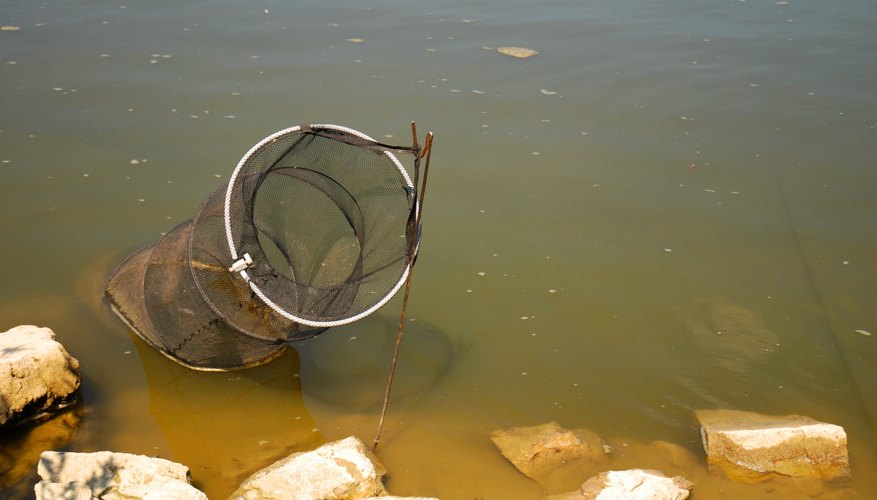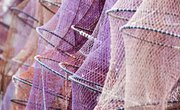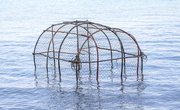
Hoop nets, also known as fyke or barrel nets, have been used for centuries to catch fish. Made of a long tube of netting and held open with large metal or fiberglass hoops, the net contains two inward facing mesh funnels. These files allow fish to enter the net but not to leave. The fisherman can then retrieve the net, open the end and empty the fish out of the net.
Check Local Laws
Different regions have different laws regarding the use of hoop nets. Also, hoop nets may be allowed in one area of the waterway but not in others. Check with your local and state fishing game service before using a hoop net, especially in public lands.
Choose the Right Bait
When baiting the hoop net, it's important to use bait that will last for a period of time, allowing the net to soak long enough for the fish to find it. Cottonseed cubes make an excellent bait for scaled fish, while compressed soybean meal and cheese baits work well for catfish, buffalo and carp.
Select a Size
Hoop nets come in a range of sizes and mesh diameters. For catching bait fish, select smaller hoop nets with netting meshes of 1 inch or less. For larger fish, use a bigger hoop net with a mesh diameter of 1 1/2 inches or better. This larger mesh size will allow smaller bait fish to pass through the net, while capturing larger fish.
Setting and Marking
To set a hoop net, tie the tapered end of the net to a stake set well in the river bottom to prevent the net from being washed away. Once secured, pull the mouth of the net away from the stake or allow the current to carry the body of the net downstream. Ensure that the mouth of the net is open and anchor the mouth securely. This position will prevent leaves sticks and other debris from being washed into the net. Mark the location with a float or buoy for easier identification and retrieval.
Harvesting
When harvesting fish from a hoop net, raise the tapered end first. Roll the net over the side of the boat until all of the fish are in the boat. Untie the tapered end and empty the net. Avoid bringing the entire net into the boat, to make for easier resetting.
Resetting
When resetting your net, ensure that there is sufficient bait in the net first. If necessary, add more. Place the net back in the same location. Fish in the region will become conditioned to finding food in this area, and a net placed in the same location will frequently catch more fish than if it were relocated.
Use a Lead Net
Sometimes it helps to use a lead net with a hoop net. Lead nets are usually box-shaped nets with a funnel on the back that leads to the mouth of the hoop. The lead net is used to help guide fish into the hoop net and can often be used to guide fish into more than one hoop net at a time.
Repair Damaged Nets
A hoop net with a hole in it that allows fish to escape is worthless. Sticks, rocks and other debris can frequently tear the nylon line that nets are made of. Be sure to inspect your nets before resetting them and repair any minor damage immediately. If the net is severely damaged, retrieve it for later repairs.
References
Writer Bio
In Jacksonville, Fla., Frank Whittemore is a content strategist with over a decade of experience as a hospital corpsman in the U.S. Navy and a licensed paramedic. He has over 15 years experience writing for several Fortune 500 companies. Whittemore writes on topics in medicine, nature, science, technology, the arts, cuisine, travel and sports.



